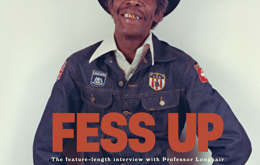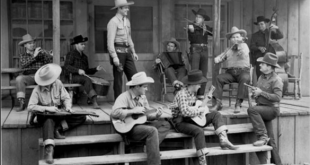Filling the niche, `model-virtuoso,’ is a task violinist Caroline Campbell tackles with panache. Stunningly blonde in black, Caroline sways as she weaves together lines from Paganini and Michael Jackson in a flamboyant showpiece introducing a new electric violin at the world’s biggest music trade show.
Every January, the National Association of Music Merchants draws some 100,000 attendees to the Winter NAMM Show at the Anaheim Convention Center. (A smaller Summer NAMM is held in Nashville.) The NAMM Show is a noisy sprawling circus of buyers and sellers and demonstrators of all things related–even remotely–to music. Its size and kinetic energy belies the apparent demise of music stores, especially the neighborhood Mom and Pop variety. NAMM champions music education, likewise on the ropes for decades. Yet each year they come by the thousands, gray men in suits with briefcases, hair band vets in black, the tailored and the tattooed, all eager to imbibe the heady NAMM rumble and roar. Who are these people? Haven’t they heard that no one plays music anymore?
Evidently not. Caroline Campbell is a striking exception to the trend, lending her considerable chops and looks and stage savvy to announce the arrival of Yamaha’s new YEV Series electric violin. (Yamaha needs more real estate to display its myriad wares than the Convention Center affords: it took over a huge wing of the nearby Marriott Hotel.) “We told the designers, `Just forget we ever made an electric violin before,’” says Ken Dattmore, marketing manager, strings, Yamaha Corporation of America. The YEV is a bold departure from prior electric fiddles, a functional abstraction of a violin, its body a swirl inspired by the Möbius strip. There’s a hook on the left side of the fingerboard, implying what’s not there (the top of the body) and providing violinists a familiar reference for fingering. “It’s several ply of walnut,” Ken says of the frame body, and there are six different woods altogether in its component parts. (The bridge, which houses the dual-piezo pickup, is maple.) The YEV design is truly stunning, and it’s reasonably priced (around $600), so it will be interesting to see if players take to it. It’s off to a good start: NAMM presented the YEV its `Best in Show’ award.
http://www.yamaha.com/us/promo/YEV_Violin/
Asked who came up with the radical `infinite loop’ shape, Ken says, “The Yamaha design team.” Like major car companies, Yamaha and other corporate players employ teams of talent to deliver fresh designs. But NAMM also hosts innovative individuals from around the world, designers looking for person-to-person connections and heightened visibility for their work.
One of these is Hervé Prudent, at NAMM for the first time from Besançon, France. “I have been making instruments for 30 years,” he says. “I taught myself.” Less radical than the YEV, Hervé’s electric violin hints at the `proto-violin’ designs of earlier bowed instruments such as the rebec and lyra but with an appealingly contemporary sleekness. Hervé makes a range of violin family instruments, all the way up to the bowed bass.
France is also home to the much higher profile French guitar company Vigier, boasting several rocker endorsees (Bumblefoot, Morglbl, Thank You Scientist). I was drawn to Vigier by guitar god Guthrie Govan’s YouTube demo of its Excaliber fretless guitar. New York-based Vigier rep DJ Scully offers a detailed explanation of what makes Patrice Vigier’s guitars, fretted and fretless, special: one feature is drying the wood used for the necks three years to insure maximal stability. He invited me to play the fretless object of my fascination with its gleaming secret alloy fingerboard. It’s a challenge, one which might be a breeze for a violinist experienced at precisely nailing a pitch on a bare fingerboard. While very much a specialty instrument, Vigier clearly makes today’s state-of-the-art electric fretless guitar.
The fretless theme continued in the new Limulus electric oud designed by New York’s Jeff Slatnick and Andy Dowty. With a horseshoe crab-shaped body, the Limulus oud is a solid neck-through-body instrument with a thin solid concave top and no back or sides. The stainless steel fingerboard is akin to that of an Indian sarod but the twelve strings make it an unconventional electric oud (the long neck scale is really more like a Turkish cümbüş). Limulus, named for the horseshoe crab, also offers an electric sitar which features a similarly thin solid body with the sitar’s characteristic buzzing javari bridge and a neck and string arrangement very like that of the traditional sitar (minus the sympathetic strings but with the chikari rhythm strings). If you’ve played sitar and aren’t a purist you’ll love not having to sit on the floor with the instrument balanced on your right foot. A guitarist unfamiliar with sitar may find the instrument’s tuning, string arrangement and the convex metal frets baffling. But Limulus (distributed by Mideast Mfg., Inc.) is making highly functional and playable electric east-west hybrids that may find a niche among adventurous players here and abroad.
http://limulusinstruments.com/?page_id=18
Some designers tweak tradition while others seem keen on ditching it entirely. Germany’s Alexander Claas, also new to Winter NAMM, falls into the latter camp. Young and soft-spoken, Alexander says, “The notion that guitar making peaked in the past is absolutely outdated,” and as evidence he offers his radically designed Moby Dick models with fanned frets and as many as nine strings. Alexander stresses the ergonomics of his designs, though conventional guitarists (this writer included) may find them daunting. Not for everybody, Alexander’s futuristic guitars show how bold designers are challenging our notions of what a guitar is (or can be).
Some new designs are more whimsical than confrontational. At least that was my reaction to the 660 Guitars some young Texans brought to NAMM. Their handout boasts of “all-American aircraft grade aluminum, carbon fiber, and 100% USA parts nd labor.” There are a few models of 660s, my favorite being a sort of Swiss cheese Gumby guitar called the CT/52.
Along with innovative designers the NAMM show offers plenty for those who prefer designs from the past but can’t afford vintage instruments. Many companies from China supply that demand, among them Altamira Guitars. Their specialty is replicating the `gypsy jazz’ guitars made in the 1930s by Selmer (and others) for the legendary Django Reinhardt and his musical kin.
http://www.altamira-guitars.com/
No trade show would be complete without entertainment, and that’s especially true for a music trade show like NAMM. Honored with a `Music for Life’ Award from NAMM, Graham Nash sang “Teach Your Children” to an overflow outdoor crowd as I elbowed my way into the Marriott to hear a surrogate Ventures band back founder Don Wilson. Opening with “Walk Don’t Run,” the group (featuring Jeff Baxter, another `16 NAMM honoree) ran through a fast 45 minutes of `60s instrumental classics. For the benefit of younger attendees who missed the Ventures in their prime, Don announced: “We sold over 110 million albums, so there!” The Wilson clan currently sells a line of guitars that were offered at NAMM. http://www.wilsonguitarventures.com/
NAMM has a staggering number of exhibitors, over 1700 this year, more than 400 of them first timers. There’s no easy way to neatly sum up what’s on offer. It’s an amped-up intersection of creativity and commerce, heavy on hoopla but also rich in diversity and innovation. It can be overwhelming but inspiring, too. Patience and stamina are good things to bring to the party, as well as curiosity about what’s new and whose dream has come to market. Some who invest in presenting this year won’t ever be back. Others are perennials. New discoveries and revisiting old friends make it exciting each year.
One of my favorite moments at Winter NAMM `16 occurred at the booth of Funguy Mojo Guitars, a company making cigar box guitar kits. A young lady, an enthusiastic unabashed novice, was strumming while haphazardly running a metal slide up the skinny neck of her instrument. Entranced by sounds that were music to no ears but her own, she said, “I love it when it goes…,” and she made a whangy high sound as she slid up the neck as far as she could. Playing with sound: that’s really where it all starts. So long as that impulse persists there will be music makers (and probably a NAMM Show).
 Baja Review A community newspaper serving Ensenada, Valle de Guadalupe, and Rosarito in Northern Baja California
Baja Review A community newspaper serving Ensenada, Valle de Guadalupe, and Rosarito in Northern Baja California





